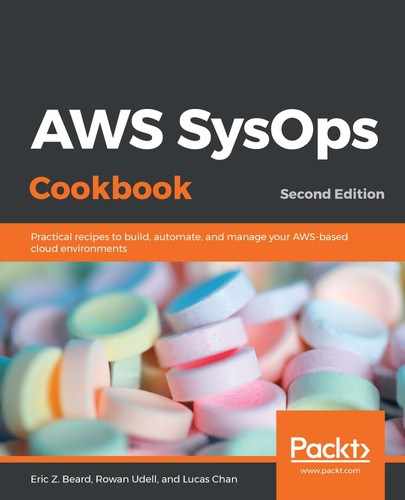In this recipe, you will create an IOPipe trial account, author a new lambda function, and observe performance information for that function as it runs. Let's get started:
- Go to the IOPipe site at https://www.iopipe.com/ and click Get Started.
- Fill out the user profile and create your trial account.
- On the following screen, enter a default team name and then click New Project. Enter a name for your project:

IOPipe setup
- Under Plans, select Lite, which is free of charge. You don't have to enter credit card details for the lite plan. Click Create Team.
- On the following screen, you will see your security token and links to tutorials for various programming languages.
- Log in to your AWS account and go to the CodeStar dashboard. CodeStar is an AWS service that allows you to create a complete serverless application, including a code repository in CodeCommit, a lambda function, a CodeBuild project, and a CodePipeline configuration so that you can automatically deploy your code after each change. We are using CodeStar for this recipe because we need to be able to install a Node.js package, which is not currently possible via the lambda console. Also, it's good practice to avoid directly editing lambda functions in the console, and CodeStar gives us a Cloud9 web-based Integrated Development Environment (IDE) for this:

Starting a new project with AWS CodeStar
- Click Start a project. You will be presented with a dialog asking you if you wish to create the CodeStar service role. Click Yes, create role:

Creating the CodeStar service role
- There are a variety of project templates to choose from with CodeStar. For this recipe, select the Node.js lambda web application:

CodeStar project templates
- Give the project a unique name and click Next. Then, click Create project.
- When you are given a choice of code editors, select AWS Cloud9:

CodeStar editor selection
- Go with the default configuration for Cloud9 and click Next.
- It will take a few minutes for CodeStar to complete the setup process, but, once it's done, you'll see a screen similar to the following:

AWS CodeStar dashboard
- Once the setup is complete, select the IDE from the left-hand side menu to open your Cloud9 environment, as follows:

AWS Cloud9
- Expand the project folder and open both index.js and template.yml. The YAML file is your Serverless Application Model (SAM) template that defines your resources, and the JavaScript file is your lambda function.
- In the Terminal window below the editor pane, install the @iopipe/iopipe NPM package using the npm install --save command, as follows:
ezb.packt.admin1:~/environment $ cd packt-iopipe/
ezb.packt.admin1:~/environment/packt-iopipe (master) $ npm install --save @iopipe/iopipe
npm notice created a lockfile as package-lock.json. You should commit this file.
+ @iopipe/[email protected]
added 85 packages from 59 contributors and audited 245 packages in 7.321s
found 0 vulnerabilities
- In the template.yml file, define an environment variable to hold your IOPipe token, as follows:
Resources:
GetHelloWorld:
Type: AWS::Serverless::Function
Properties:
Handler: index.get
Runtime: nodejs8.10
Environment:
Variables:
IOPIPE_TOKEN: [YOUR TOKEN HERE]
Role:
Fn::GetAtt:
- LambdaExecutionRole
- Arn
Events: [...]
- Also in the template.yml file, change the deployment type to be AllAtOnce, which will speed up the deployment for testing purposes:
Globals:
Function:
AutoPublishAlias: live
DeploymentPreference:
Enabled: true
Type: AllAtOnce
Role: !Ref CodeDeployRole
- To make a change to the deployment preference, you will need to modify the policy attached to the CodeStar CloudFormation role. Go to the IAM dashboard and search for a role named CodeStarWorker-[PROJECT NAME]-CloudFormation.
- Edit the inline policy in that role to include codedeploy:UpdateDeploymentGroup, as follows:

Editing the CodeStar CloudFormation policy to allow changes to deployment preferences
- Modify the lambda function in index.js so that it uses the IOPipe wrapper:
'use strict';
var fs = require('fs');
var path = require('path');
var iopipe = require('@iopipe/iopipe')();
exports.get = iopipe(function(event, context, callback) {
var contents = fs.readFileSync(`public${path.sep}index.html`);
var result = {
statusCode: 200,
body: contents.toString(),
headers: {'content-type': 'text/html'}
};
callback(null, result);
});
- Save index.js and template.yml.
- Create a .gitignore file and add node_modules to it, since you don't want to commit all of the NPM packages that have been installed. Then, commit your changes to the CodeCommit repository, as follows:
ezb.packt.admin1:~/environment/packt-iopipe (master) $ git add .
ezb.packt.admin1:~/environment/packt-iopipe (master) $ git commit -m "IOPipe"
ezb.packt.admin1:~/environment/packt-iopipe (master) $ git push
- CodeStar will detect the change to the repository and kick off the CodePipeline project that was automatically set up for you. Go back to the CodeStar dashboard to watch the progress of your build:

CodeStar deployment progress
- Once the deployment progress has completed, scroll up to application endpoints and click the URL for your application to test it:

CodeStar automatically deploys your application to a production endpoint after each push
- Refresh that page a few times so that we have a few lambda invocations to track using IOPipe.
- Go back to the IOPipe dashboard and look at the invocations:

IOPipe dashboard: The text and numbers in this image are intentionally illegible
- Click the name of the function at the bottom of the screen to see details about the function:

IOPipe function details: The text and numbers in this image are intentionally illegible
You now have experience with rapidly creating a new web application with AWS CodeStar and wiring up detailed tracing to your Lambda function with IOPipe. Take some time to explore the functionality offered by IOPipe, and then, if you no longer need this CodeStar project, be sure to delete it so that you do not incur any future charges on your AWS account.
